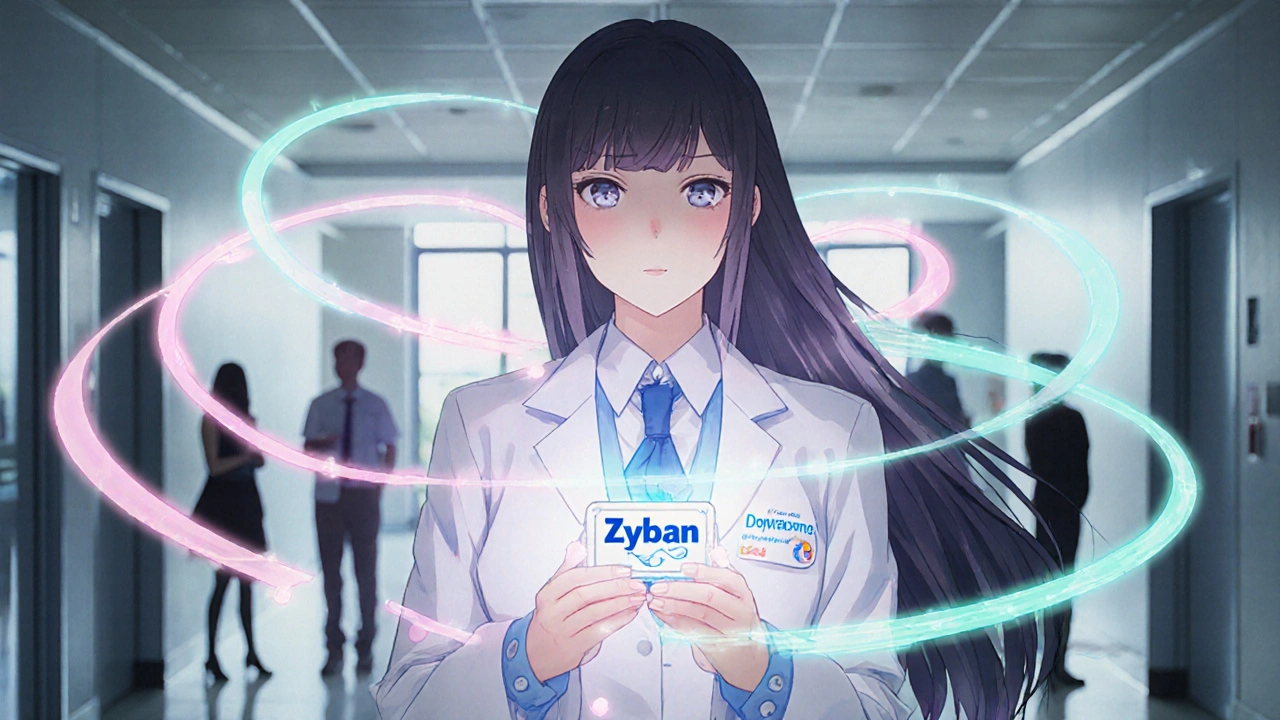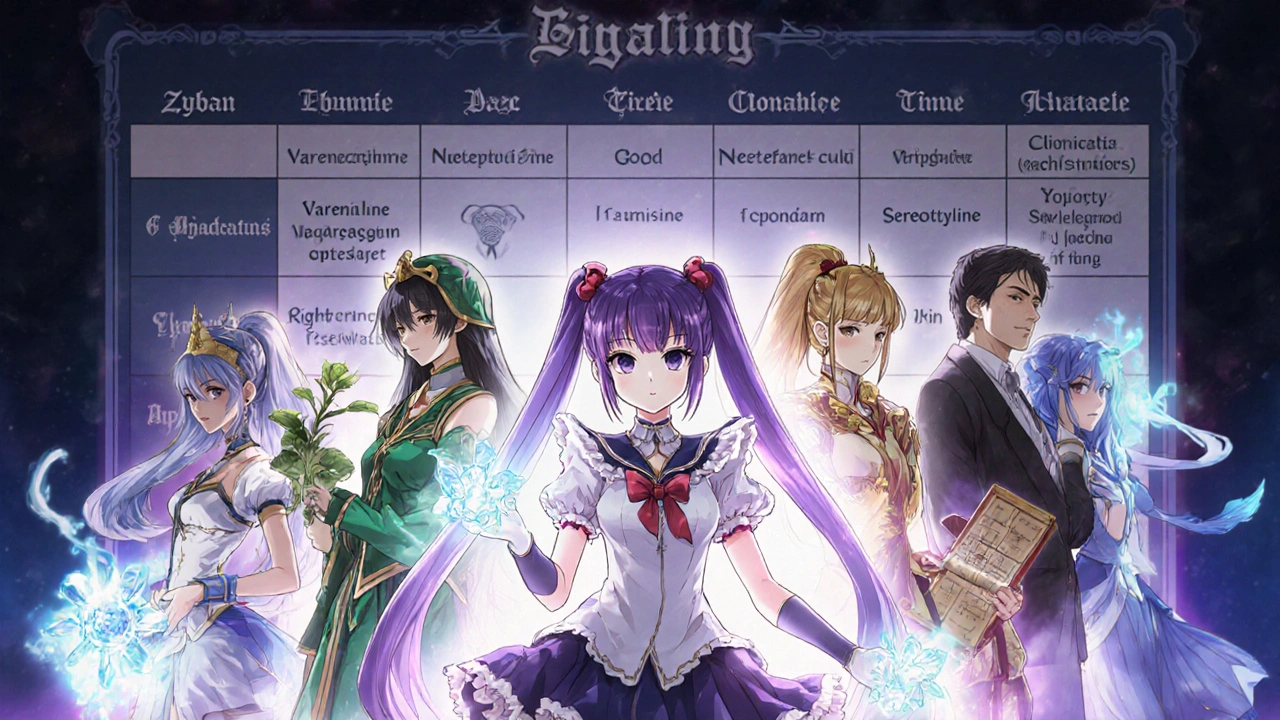 Oct, 24 2025
Oct, 24 2025
If you’ve tried to quit smoking and wonder whether Zyban (Bupropion) is the right choice, you’re not alone. Hundreds of people compare this antidepressant‑turned‑stop‑smoking aid with patches, gums, and newer prescription pills every year. This guide breaks down how Zyban works, weighs it against the most common alternatives, and helps you decide which option fits your health profile.
Key Takeaways
- Zyban works by reducing nicotine cravings and withdrawal symptoms through dopamine and norepinephrine pathways.
- Varenicline (Champix) targets nicotine receptors directly and often shows higher quit rates but can cause mood changes.
- Nicotine Replacement Therapy (NRT) - patches, gums, lozenges - delivers low‑dose nicotine without affecting brain chemistry.
- Cytisine, a plant‑derived alkaloid, is a low‑cost option approved in Europe but not yet in the U.S.
- Older off‑label drugs like nortriptyline and clonidine work for a subset of smokers who cannot tolerate first‑line therapies.
What Is Zyban (Bupropion)?
Zyban is a brand name for bupropion, an atypical antidepressant that was repurposed for smoking cessation in 1997. The drug blocks the reuptake of dopamine and norepinephrine, reducing the brain’s reward response to nicotine. It received FDA approval for helping adult smokers quit and is prescribed as a 150 mg tablet taken twice daily for 7‑12 weeks.
How Zyban Works: Mechanism of Action
The primary way Zyban eases quitting is by increasing the levels of dopamine and norepinephrine in the brain. These neurotransmitters counteract the drop that occurs when nicotine is removed, smoothing out cravings and mood swings. Unlike nicotine‑based products, Zyban does not provide any nicotine at all, so there’s no risk of developing a new nicotine dependence.
Choosing Comparison Criteria
Before diving into alternatives, it helps to line up the factors most people care about:
- Efficacy - measured by quit rates in clinical trials.
- Side‑effect profile - common adverse events and serious warnings.
- Cost & accessibility - price per treatment course and insurance coverage.
- Dosing convenience - daily pills vs patch vs gum.
- Contraindications - health conditions that rule out a drug.
Alternative #1: Varenicline (Champix)
Varenicline is a partial agonist at the α4β2 nicotinic acetylcholine receptor. By binding to the same receptor nicotine targets, it blunts the “reward” feeling while still providing a mild stimulus that eases withdrawal.
Clinical trials report a 44‑45 % quit rate after 12 weeks, slightly higher than Zygan’s 30‑35 % range. However, side effects include vivid dreams, nausea, and, in rare cases, mood disturbances. Varenicline is contraindicated for patients with uncontrolled psychiatric illness.

Alternative #2: Nicotine Replacement Therapy (NRT)
Nicotine patches, gums, lozenges, inhalers, and nasal sprays belong to the same family: delivering nicotine without the harmful tar and carbon monoxide found in cigarettes.
Nicotine Patch provides a steady dose over 16‑24 hours, ideal for those who prefer a “set‑and‑forget” routine. Common side effects are skin irritation and sleep disturbances if worn overnight.
Nicotine Gum lets users control the dose by chewing when cravings hit. It can cause jaw soreness or mouth irritation but offers quick relief.
Meta‑analyses show NRT yields about a 30‑35 % quit rate, comparable to Zyban, but with the advantage of no mood‑altering psychiatric effects. Cost varies: patches are often covered by NHS prescriptions, while gums may require a co‑pay.
Alternative #3: Cytisine
Cytisine is a plant‑derived alkaloid extracted from the golden rod species Laburnum anagyroides. It acts as a partial agonist at the same nicotinic receptors as varenicline, but at a fraction of the price.
European trials (e.g., the 2023 Czech study) reported quit rates of 25‑30 % after 12 weeks. Side effects are usually mild - nausea, dry mouth, and vivid dreams. Cytisine is not yet FDA‑approved in the United States, but it is available over‑the‑counter in several EU countries.
Alternative #4: Nortriptyline (Pamelor)
Nortriptyline is a tricyclic antidepressant that has been used off‑label for smoking cessation since the 1990s. It blocks the reuptake of serotonin and norepinephrine, similar to how Zyban raises norepinephrine levels.
Studies show a modest 20‑25 % quit rate, lower than both Zyban and varenicline, but it can be useful when first‑line drugs are contraindicated (e.g., in patients with a history of seizures). Main side effects include dry mouth, constipation, and weight gain.
Alternative #5: Clonidine
Clonidine is an alpha‑2 adrenergic agonist originally used for hypertension. It reduces sympathetic outflow, which can blunt nicotine withdrawal symptoms such as anxiety and irritability.
Evidence from a 2022 Cochrane review suggests a quit rate of roughly 15‑20 % when used alone, but it improves success when combined with NRT. Side effects are low blood pressure, dry mouth, and sedation.
Side‑by‑Side Comparison Table
| Drug | Mechanism | 12‑week Quit Rate | Common Side Effects | Typical Cost (UK) | Prescription Needed? |
|---|---|---|---|---|---|
| Zyban (Bupropion) | Dopamine & norepinephrine reuptake inhibitor | 30‑35 % | Insomnia, dry mouth, tremor | £60‑£80 for 12‑week course | Yes |
| Varenicline | Partial nicotinic receptor agonist | 44‑45 % | Nausea, vivid dreams, mood changes | £120‑£160 | Yes |
| Nicotine Patch | Transdermal nicotine delivery | 30‑35 % | Skin irritation, sleep disruption | £30‑£45 (7‑day supply) | Usually OTC or prescription |
| Cytisine | Partial nicotinic receptor agonist (plant‑derived) | 25‑30 % | Nausea, dry mouth, vivid dreams | ≈£20‑£30 for 12‑week pack (EU) | OTC in EU, not US |
| Nortriptyline | Tricyclic antidepressant (serotonin & norepinephrine reuptake inhibition) | 20‑25 % | Dry mouth, constipation, weight gain | £25‑£35 for 12‑week course | Prescription |
| Clonidine | Alpha‑2 adrenergic agonist (reduces sympathetic activity) | 15‑20 % (alone) | Low blood pressure, dry mouth, sedation | £10‑£15 for 12‑week supply | Prescription |

Which Option Fits Your Situation?
Below is a quick decision‑tree you can follow while talking to your GP or pharmacist:
- If you have a history of depression or are already on an antidepressant, Zyban might be a natural fit because it doubles as an antidepressant.
- If you prefer a medication that directly targets nicotine receptors and you have no major psychiatric concerns, consider Varenicline.
- If you want a non‑drug approach or have trouble swallowing pills, start with Nicotine Patch or Nicotine Gum.
- If cost is a major barrier and you live in the EU, explore Cytisine as a low‑price alternative.
- If you cannot tolerate any nicotine‑based product and have no seizure risk, discuss off‑label Nortriptyline with your prescriber.
- If blood‑pressure medication is already part of your regimen, Clonidine may kill two birds with one stone.
Practical Checklist Before Starting
- Confirm no seizures, eating disorders, or recent MAO‑inhibitor use (contraindication for Zyban).
- Check current medications for drug‑drug interactions - especially SSRIs, other antidepressants, or antihypertensives.
- Ask about insurance coverage; many NHS plans cover NRT and varenicline but not always Zyban.
- Plan a quit‑day and set realistic expectations - most relapses happen within the first 2 weeks.
- Arrange follow‑up appointments (in‑person or telehealth) to monitor side effects and adjust dosage.
Common Pitfalls & How to Avoid Them
Skipping the titration period. Zyban must start a week before your quit‑day. Jumping straight to the full dose raises seizure risk.
Combining multiple nicotine sources. Using both a patch and gum can lead to nicotine overload and side effects like nausea.
Ignoring mental‑health cues. If you notice worsening mood on varenicline or Zyban, contact your GP immediately - mood changes are a known warning sign.
Next Steps & Resources
When you’ve narrowed down the best option, follow these steps:
- Schedule a 15‑minute appointment with your GP or community pharmacist.
- Bring a list of current medications, allergies, and any past quit‑attempt details.
- Ask for a printed quit‑plan that includes dosage schedule, side‑effect management, and a follow‑up date.
- Consider joining a local support group - many cities (including Bristol) run NHS‑backed cessation meetings.
- Track your progress daily in a notebook or a free app like QuitNow! to stay motivated.
Frequently Asked Questions
Can I use Zyban and nicotine patches together?
Yes, combining Zyban with a nicotine patch is allowed and can improve quit rates for heavy smokers. The patch supplies a steady nicotine dose while Zyban tackles cravings from a neurotransmitter angle. However, you should avoid adding nicotine gum or lozenges on top of the patch to prevent excess nicotine.
What if I miss a dose of Zyban?
Take the missed tablet as soon as you remember, unless it’s close to the next scheduled dose. In that case, skip the missed pill and resume the regular twice‑daily schedule. Never double‑dose.
Is Zyban safe for pregnant women?
Bupropion is classified as Category B in the UK, meaning animal studies show no risk but there are no well‑controlled studies in pregnant women. Most clinicians avoid prescribing it during pregnancy and recommend NRT or behavioral support instead.
How long do I need to stay on Zyban after quitting?
The standard course is 12 weeks, with the first week being a low‑dose run‑in. Some doctors extend treatment to 16 weeks for heavy smokers or those who relapse early.
Can I switch from Varenicline to Zyban if I experience side effects?
Yes, a short taper off Varenicline (usually a 2‑day reduction) followed by a 7‑day run‑in of low‑dose Zyban is a common strategy. Always do this under medical supervision.
Quitting smoking isn’t a one‑size‑fits‑all journey. Whether you land on Zyban, varenicline, a nicotine patch, or an older off‑label drug, the key is matching the medication’s strengths to your health status and lifestyle. Use the comparison table, checklist, and FAQ as your roadmap, and remember that professional guidance plus a solid support network dramatically boost your odds of staying smoke‑free.
Tamara Tioran-Harrison
October 24, 2025 AT 21:07Well, congratulations on discovering yet another “magic” smoking‑cessation drug 🙃.
kevin burton
November 1, 2025 AT 23:33For anyone weighing options, it helps to remember that Zyban works on brain chemistry rather than delivering nicotine, so you won’t be adding a new addiction. Its typical quit‑rate sits around 30‑35 %, which is comparable to the patch but without the nicotine buzz. Side‑effects often include insomnia and dry mouth, so timing the first dose earlier in the day can mitigate sleep disruption. Discuss with your doctor whether your medical history makes Zyban a safer choice than varenicline or NRT.
Olivia Harrison
November 10, 2025 AT 02:00That’s a solid summary; I’d add that patients with a history of depression may actually benefit from the antidepressant properties of bupropion. It’s also worth checking insurance formularies early to avoid surprise costs. A supportive quit‑plan and regular follow‑ups can make the difference between a short‑term quit and lasting abstinence.
Nathan Comstock
November 18, 2025 AT 04:27Listen, if you’re tired of being a slave to nicotine, Zyban is the bold middle ground between a nicotine patch and a full‑blown psychiatric drug. It hits your dopamine and norepinephrine pathways, giving you that “I’m in control” feeling without the smoke. The only drama comes if you ignore the seizure warning – that’s a line you don’t want to cross. So, start the low dose a week before D‑day, keep a pill schedule, and you’ll walk away feeling like you’ve conquered a personal battle.
Grace Silver
November 26, 2025 AT 06:53the act of quitting becomes a meditation on self the medication is merely a tool it redirects attention from the chemical craving to the rhythm of breath and thought while the brain rewires a new pattern of reward if you treat it as a ritual rather than a quick fix the journey gains depth
Terell Moore
December 4, 2025 AT 09:20One must first acknowledge the epistemic hubris inherent in the layperson’s expectation that a single pharmacologic agent can rectify the multifaceted sociopsychological phenomenon of nicotine dependence. Zyban, whose active moiety is bupropion, ostensibly operates by antagonizing the reuptake of catecholamines, thereby modulating the reward circuitry in a manner that is intellectually appealing yet clinically modest. The seminal trials report quit rates hovering in the low‑mid thirties, a statistic that, when juxtaposed with the varenicline data approaching the mid‑forties, underscores a relative inferiority that is often glossed over in popular discourse. Moreover, the side‑effect profile-insomnia, dry mouth, tremor-constitutes a nontrivial trade‑off, particularly for patients whose occupational demands require nocturnal vigilance. The pharmacokinetic requirement of a titration phase, wherein dosage is incrementally elevated over a seven‑day period, further complicates adherence for individuals prone to impulsivity. One cannot ignore the contraindication in patients with a seizure proclivity; the catastrophic potential of a drug‑induced seizure eclipses the modest benefit of incremental smoking reduction. Economically, the cost bracket of £60‑£80 for a twelve‑week course situates Zyban within a middle tier, rendering it inaccessible to those without comprehensive insurance coverage, unlike over‑the‑counter nicotine replacement therapies. A comparative analysis of the mechanistic divergences reveals that while NRT delivers exogenous nicotine to satiate withdrawal, Zyban’s indirect modulation may, in theory, attenuate the conditioned cues associated with smoking, yet empirical validation remains equivocal. The psychoactive dimension of bupropion also raises ethical considerations: is the prescriber ameliorating nicotine withdrawal or inadvertently subjecting the patient to an off‑label antidepressant effect? From a public health perspective, the therapeutic index of Zyban is dwarfed by the brisk adoption of varenicline, which, despite its own neuropsychiatric controversies, boasts a more favorable absolute risk reduction. Nevertheless, for the subset of patients with comorbid depressive symptomatology, Zyban presents a dual‑purpose pharmacotherapy that may streamline polypharmacy. Clinicians must therefore navigate a labyrinthine decision matrix, balancing efficacy, safety, cost, and patient preference. In summation, while Zyban occupies a legitimate niche within the armamentarium against tobacco use, its utility is circumscribed, and its promotion should be tempered by sober recognition of its limitations.